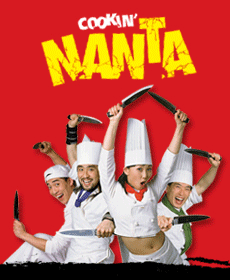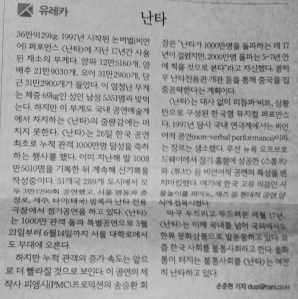Nanta (난타) was the very first performance I saw in Korea, back in the rainy spring of 2006. In the short time span of one week, we did all kinds of sightseeing, from the Folk Village to Gyeongbok Palace, from the National Museum in Gyeongju to the Posco factories in nearby Ulsan. Shortly after arriving in Korea, after a day trip to the DMZ and dinner at an Italian restaurant, we went to the Nanta Theatre. I don’t remember the exact location, possibly in Myeongdong?, but I remember that I was very tired after some sleepless days. So I was glad that our seats way in the back were quite right for a short nap (a sacrilege for a student of theatre, I know…). This is what I wrote later about this particular night:
A déjà vu: The posters that announce the “crazy chefs” look somewhat familiar. And sure enough, a few years ago Nanta had been performed in Berlin! Expecting the worst, I take a seat in a back row. The interior of the theatre appears a bit old-fashioned. LCD-displays in four languages encourage the audience to applaud. Then three chefs enter the stage and begin with their main occupation during the next two hours: drumming with everything possible on all things anywhere. The plot about the restaurant manager’s nephew who steps in on short notice for an urgent wedding banquet is mere pretext. The cooks slice cabbage, dance wildly, hold a baking contest, balance and juggle with dishes—and they keep on drumming. My expectations are disappointed. Nanta is, in fact, great fun!
– from my travel report, 23 May 2006.
The reason I thought of Nanta again was a short column by Son Jun-hyeon in today’s hankyoreh (한겨레). The following is a rough translation of the article:
The vegetables used in Nanta since the 1st performance in 1997 weigh 369,129 kg in total. 125,160 onions, 219,030 heads of cabbage, 312,900 cucumbers, 312,900 carrots. […] But this immense weight cannot account for the massive influence of Nanta in taking the world of performing arts in Korea by storm. More than 10 Mio. (10,085,010) spectators saw the show by the end of last year. There have been 31,290 performances in 289 cities in 51 countries, two dedicated theatres in Seoul (Myeongdong, Chungjeong-ro), on Jeju Island, and in Bangkok. In celebration of the 10 Millionth spectator, this year from March 21 to June 14 performances will also be held in Daehangno.According to Song Seung-hwan (송승환), head of PMC Productions, the 20 Mio. mark will be reached in the next five to seven years. With a a dedicated theatre in Guangzhou, the efforts will concentrate on China. […] Beating wildly for 17 years, Nanta now crosses the borders of Korea and, as a hallyu[-related] cultural commodity (한류 문화상품), is tiptoeing to foreign countries, too. Recently, the Korean society has been characterized as a ‘damaged society’ (불통사회). Nanta can still strike up (난타하다) this ‘damaged society’ that is bursting of anger and rage.
While the last paragraph seems more like a rhetoric device than an actual assession of the critical potential of Nanta (the show is, as the article mentions, a “cultural commodity”, after all), I find he concept of “non-verbal performance” (넌버벌 / 무언어 퍼포먼스) quite fascinating, as it addresses implicitly the obsession with foreign evaluation in the world of arts (and beyond) in Korea. Downplaying the language, an aspect that might hinder accessibility by non-Korean audiences, is a very clear step towards creating an easily digestible show, rather than a showcase of Koreanness. In the case of Nanta, economic goals seem to trump cultural politics.
Hyunjung Lee argues in her PhD dissertation on “Global Fetishism” that Nanta follows a slightly different paradigm than typical works with nationalist content and global aspirations, such as the musical The Last Empress, Lee’s other case study. In addition to aiming for recognition (and profits) in the “West”, the staging and marketing strategies employed in Nanta also address audiences from (or in) other Asian countries, “via performance elements that, by revealing inviting qualities of Korean culture in the context of other Asian cultures, reflect ideas of Asian solidarity or pan-Asianism”. (Hyunjung Lee, Global fetishism: Dynamics of Transnational Performances in Contemporary South Korea, PhD diss., The University of Texas at Austin, 2008, p. 12) This has a downside, too. For Nanta performances outside of Asia the title was changed to Cookin’ and several aspects of the show were modified to address an audience not accustomed to (or interested in) Korean culture in particular. Instead, “Song’s ways of reaching the Cookin’s New York audience reveal concrete marketing procedures and sensitivity to the play’s intercultural reception, rather than adherence to an exclusivist idea of Korean traditional cultural uniqueness.” This interpretation seems a bit too positive, though, as Lee continues in the next paragraph to describe the “pan-Asian images” used, including dumplings, kungfu, benihana (apparently a Japanese-style restaurant chain), a “fusion of Asian images and themes [that] resonates with the popular Asian stereotypes circulating in the U.S. media.” (both quotes p. 107)
As the music and rhythms of Nanta are heavily inspired by samulnori, I also found these two quotes by Song Seung-hwan (송승환), the “inventor” of Nanta, very interesting:
[A]s a matter of fact, I’ve decided to adopt samulnori as a way of targeting the world market.
– 송승환, 세계를 난타한 남자: 문화 CEO, 송승환, 서울 2003: 북키앙, p. 68 (transl. and quoted in Lee 2008, p. 99; details on the book at Daum.)
[W]ith Nanta’s popularity, I hope that we will be able to demonstrate before the foreigners that there is something more besides pansori in our proud Korean cultural assets.
– 송승환, 매일경제신문, 14 Jan. 1999 (ibid.)
Hyunjung Lee’s very interesting dissertation is definitely worth a read. And according to her faculty site, there seems to be a book on the way, too: Hyunjung Lee, Performing the Nation in Global Korea: Transnational Theatre, Palgrave Macmillan, 2015.
Update: The book has just been published and it includes some additional chapters on other transnational performance phenomena, including internationally acclaimed Korean Shakespeare productions and the box-office hit rock musical _Line 1_ (지하철 1호선), an adaptation of the German _Linie 1_ by Goethe-Medal-winner Kim Min’Gi (김민기). See the publisher’s homepage for details.
In addition, there are also quite a few of Korean theses and papers on Nanta, as a short keyword-search at the RISS-database reveals (“난타”: 32 journal articles, 13 MA-theses). Several of those actually deal with Nanta-inspired performances by school children (and their effect on stress reduction etc.) such as the one by members of a middle school club shown in this Youtube-video, indicating that “Nanta” is leaving the commercial realm. Will “Nanta” become some kind of “Samulnori 2.0” eventually, a b(r)and name turned neb-traditional genre? In any case, the drumming goes on, most recently on a cruise ship to Malaysia.
– 28 Jan. 2015 (水)






Hi — My name is Hyunjung Lee, I came across this post by chance and it is good to see that you have quoted from my old work! FYI, my book, just came out from Palgrave Macmillan.
Dear Hyungjung, thanks for your comment. I updated the post — and I’m looking forward to reading your book! -jan
My goodness! Thanks for sharing this information on your blog. Your research sounds quite intriguing and it might be interesting to do a collaboration (like conference panel? etc.) in the near future. I think I also have you over at FB, so keep in touch! –Hyunjung
Sounds great — I’ll keep in touch! -jan